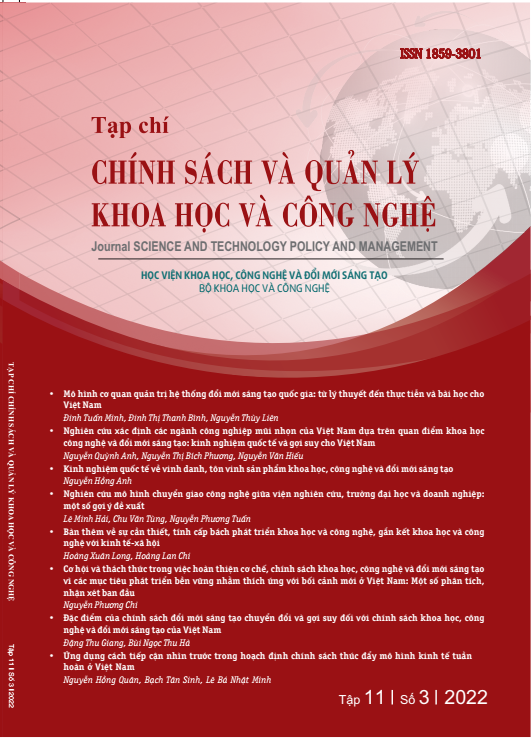Characteristics of transformative innovation policy and implications for science, technology and innovation policy in Vietnam
Keywords:
Science, technology and innovation, Transformative innovation, Transformative innovation policy, Sustainable developmentAbstract
The world is facing rapidly increasing social challenges and uncertainties that make it difficult for existing views on the goals and tools of science, technology and innovation (STI) policies to address current crises and pose a need for alternatives. In this context, STI policy researchers are increasingly interested in developing a STI policy framework capable of enhancing innovation capacity and cooperation among stakeholders, minimizing socio-technical constraints, promoting resilience and risk prevention, uncertainty and lack of knowledge. This policy framework is called the Transformative Innovation Policy. This article aims to review the existing research on the characteristics of the transformational innovation policy, thereby, drawing some implications for the development STI policy of Vietnam.
Code: 22121601
Downloads
References
OECD (2005). Oslo Manual, Guidelines for collecting and interpreting innovation data, Third edition.
OECD. (2017). Oslo Manual, The measurement of scientific and technological activities, proposed guidelines for collecting and interpreting technological innovation data,
Diercks, G., Larsen, H., and Steward, F. (2019). “Transformative innovation policy: Addressing variety in an emerging policy paradigm”. Research Policy, 48(4), 880-894.
European Commission, Enterprise Directorate General, 2000.
Frank W. Geels (2004). “From Sectoral Systems Of Innovation To Socio-Technical Systems: Insights About Dynamics And Change From Sociology And Institutional Theory”. Research Policy 33(6-7):897-920.
Garud R., Karnøe P. (2003). “Bricolage versus breakthrough: Distributed and embedded agency in technology entrepreneurship”. Research Policy, 32, 277-300.
Johan Schot , W. Edward Steinmueller (2018). Three frames for innovation policy: R&D, systems of innovation and transformative change. Science Policy Research Unit (SPRU), University of Sussex, UK.
Matthias Weber, Harald Rohracher (2012). Legitimizing research, technology and innovation policies for transformative change: Combining insights from innovation systems and multi-level perspective in a comprehensive ‘failures’ framework.
Matsui, Takanori & Suzuki, Kanoko & Ando, Kyota & Kitai, Yuya & Haga, Chihiro & Masuhara, Naoki & Kawakubo, Shun. (2022). A Natural Language Processing Model for Supporting Sustainable Development Goals: Translating Semantics, Visualizing Nexus, and Connecting Stakeholders. Sustainability Science. 10.1007/s11625-022-01093-3.
Raven and Walrave (2018). Overcoming transformational failures through policy mixes in the dynamics of technological innovation systems. Technological Forecasting and Social Change.
Rip, A., and Kemp, R. (1998). “Technological change”. In S. Rayner, & E. L. Malone (Eds.), Human choice and climate change: Vol. II, Resources and Technology (327-399). Battelle Press.
Rotmans, J., Kemp, R. and van Asselt, M. (2001). “More evolution than revolution: transition management in public policy”, Foresight, Vol. 3 No. 1, pp. 15-31. <https://doi.org/10.1108/14636680110803003>
Stefan Kuhlmann, Arie Rip, (2018). “Next-Generation Innovation Policy and Grand Challenges”, Science and Public Policy, Volume 45, Issue 4, August 2018, pp 448–454, <https://doi.org/10.1093/scipol/scy011>
Johan Schot, W. Edward Steinmueller (2018). “Three frames for innovation policy: R&D, systems of innovation and transformative change”, Research Policy, Volume 47, Issue 9, November 2018, Pages 1554-1567.
Downloads
Published
How to Cite
Issue
Section
License
Authors who publish with this journal agree to the following terms:
- Authors retain copyright and grant the journal right of first publication with the work simultaneously licensed under a Creative Commons Attribution License that allows others to share the work with an acknowledgement of the work's authorship and initial publication in this journal.
- Authors are able to enter into separate, additional contractual arrangements for the non-exclusive distribution of the journal's published version of the work (e.g., post it to an institutional repository or publish it in a book), with an acknowledgement of its initial publication in this journal.
- Authors are permitted and encouraged to post their work online (e.g., in institutional repositories or on their website) prior to and during the submission process, as it can lead to productive exchanges, as well as earlier and greater citation of published work (See The Effect of Open Access).

